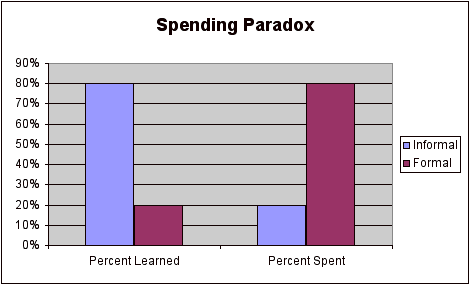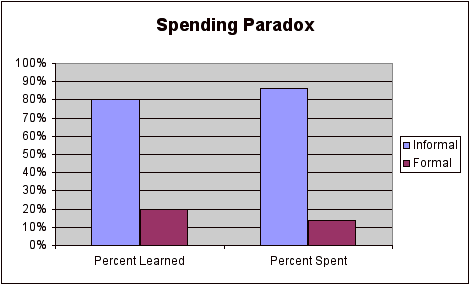Two recent posts got my attention -- Tony Karrer's Reduce Searching Start Talking and Harold Jarche's Effective knowledge sharing.
Harold notes the 80-20 funding ratio between formal and informal learning and Will Thalheimer questions this funding differential in the comment section. That is, 20% of the learning in organizations is formal, while 80% is informal; however, organizations spend 80% on formal learning and only 20% on informal, thus it looks something like this:

Chart 1
Yet the numbers pertaining to spending were pulled out of thin air (Cross, 2007, p.17). What is perhaps even more interesting is that (Carnevale, Gainer, & Villet (1990, p. 23) reported the amount of employer investments in workplace training hovers around $210 billion annually. Of that, about $30 billion is spent on formal training, while the remainder, $180 billion is spent on informal or on-the-job training. Thus, informal learning gets 86% of all learning investments, while formal learning programs get 14% of the total investment:

Chart 2
But the trouble with their report is that they do not mention where they got their numbers. So which chart do we believe?
Well, if we go with Chart 1 then we don't have to worry about informal learning since its already a highly efficient learning machine. Our time is better spent with the formal part of learning. After all, we know that we have highly detailed processes that must be learned in order to ensure that our customers receive the correct product and service, compliance and safety issues, plus the development programs our leaders want to implement. Thus why waste our time with something so highly efficient?
However I tend to believe the learning to spending ratios look closer to second chart, but probably for a couple of different reasons than where the authors of the book got their numbers from.
First, Allen Tough (1999), a Professor Emeritus at the University of Toronto and a thought leader on informal learning, wrote that within each informal learning episode (where the primary motivation is to gain and retain certain knowledge and skills on a task), the average learner interacts with an average of 10 people. Thus rather than informal learning being a solitary act, these learners are interrupting the daily activities of their coworkers as they seek advice and coaching.
Compare this with formal learning that gets its efficiency from a learning designer who works with the SME(s) to gather the needed knowledge and skills and then packages it in a platform to be used by a number of learners.
The second reason why informal learning is less efficient is that searches often end in failure. Outsell reports that searches fail 30% of the time, while IDC estimates that enterprises employing 1,000 knowledge workers may waste well over $6 million per year each in searching for information that does not exist, failing to find information that does, or recreating information that could have been found but was not (Sherman & Feldman, 2003).
Thus it is for these two reasons that I believe that informal learning is not the highly efficient method as shown in chart 1, but rather it looks more like chart 2, but perhaps not quite as bad, which means that the learning profession needs to be more involved with it. Again, if it was all that efficient then we should just stay out of its way.
How Do We Increase the Efficiency of Informal Learning?
The report that Tony and Harold discuss in their recent posts seem to confirm this: 1) sharing personal advice (interacting with others to learn informally) does not save time and 2) codified knowledge (searching for information) does not improve work quality.
This means we have two primary areas to concentrate on. The first is improving social networks (means for sharing personal advice) so that when learners need to find an "expert" on a particular subject they have both an easily searchable database and the means to have a discussion with them, either face-to-face or through an electronic means.
The second is improving the quality of captured information (codified knowledge). The problem nowadays is not so much as capturing knowledge but rather capturing the correct knowledge. That is, most of the knowledge capturing being performed now is what an expert already knows and has known for some time. Yet learners are not for the most part looking for this type of information because they already know it, thus they are wasting time researching data that is already known to them. People searching for information will generally have roughly the same knowledge levels of others in their field. What they are mostly searching for are lessons learned -- what have others in their field have recently learned. Perhaps the best example of this is the U.S. Army's After Action Review (AAR).
"The Army's After Action Review (AAR) is arguably one of the most successful organizational learning methods yet devised. Yet, most every corporate effort to graft this truly innovative practices into their culture has failed because, again and again, people reduce the living practice of AAR's to a sterile technique." -- Peter Senge
AARs are not a means to capture what you think others may want to learn, but what you have learned. It is normally accomplished by discussing four areas:
- What was supposed to happen? (confirm baseline)
- What actually happened? (confirm performance)
- Why did it happen that way? (knowledge harvesting)
- What did we learn? (learning shared)
Now while you will probably not use an AAR for every lesson learned, but rather the concept behind it of sharing newly learned knowledge and skills, rather it be through blogs, wikis, discussions groups, or other means.
References
Carnevale, A., Gainer, L., & Villet, J. (1990). Training in America: The Organization and Strategic Role of Training. San Francisco: Jossey-Bass.
Cross, J. (2007). Informal Learning: Rediscovering the Natural Pathways That Inspire Innovation and Performance. San Francisco: John Wiley & Sons, Inc.
Sherman, C. and Feldman S. (2003). The High Cost of Not Finding Information. International Data Corporation Report #29127, 11 pp., April 2003.
Tough, A. (1999). Reflections on the Study of Adult Learning: A brief talk at the 3rd New Approaches to Lifelong Learning (NALL) Conference, Ontario Institute for Studies in Education of the University of Toronto. NALL Working Paper #08-1999. Feb 19, 1999, NALL, Toronto.
3 comments:
Great post. I've seen several debates on the spending chart. It likely depends on what you count as spending. If you went into a typical T&D department and asked them how they allocated their budget, likely their answer would be even higher on the formal side. However, likely if you ask someone who's outside of T&D they would have a very different answer. Especially since you can't really separate work and learning for concept workers.
But what's even better is that you've jumped right onto what really matters is how we can do all of this better. I think the AAR pattern is excellent, and we also need to instill lightweight versions of that and a culture around it.
I hope there's lots of discussion on exactly this question - how do organizations improve informal learning.
Tony, I think instilling a culture by gleaming knowledge from "lessons learned" falls into the 80/20 rule. That is, 20% of the knowledge presently being captured in most organizations is of recent lessons learned, yet it accounts for 80% of useful information to others, while the other 80% of the captured knowledge is what the experts have been doing for sometime, but is of little use to most workers.
I agree that the typical Learning Department would agree that it spends more on formal learning, but I think what is more relevant is what the total organization spends on learning within the organization and as I have argued it spends a far greater amount on the inefficiencies of informal learning. If you cannot identify its shortcomings then you cannot improve it.
Don, the post gives a great insight into the organizational situation. All points made a really valid and urge one to think about their social learning strategy. Another factor that may hinder social learning, is participation and I was planning a post on that and throwing some open questions. Thanks so much for sharing this!
Sreya
Post a Comment